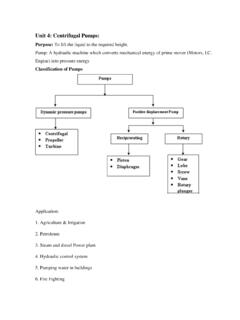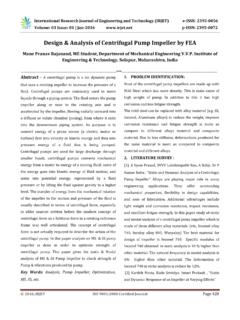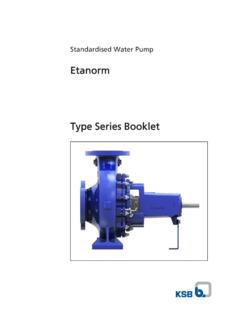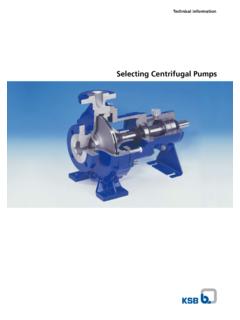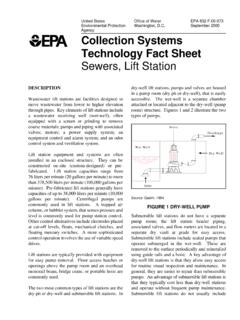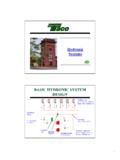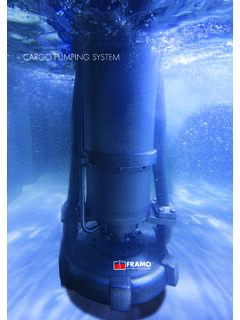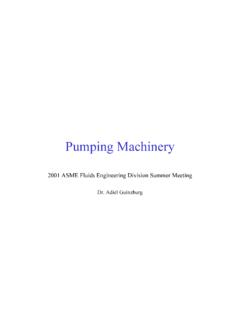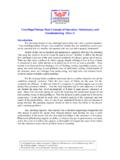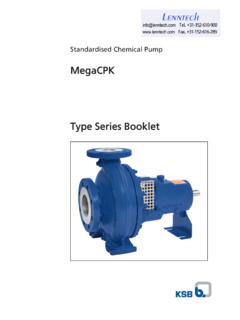Transcription of FUNDAMENTALS OF FLUID MECHANICS Chapter 12 Pumps …
1 1 FUNDAMENTALS OFFUNDAMENTALS OFFLUID MECHANICSFLUID MECHANICSC hapter 12 Pumps and Chapter 12 Pumps and TurbinesTurbinesJyhJyh--CherngCherngShie hShiehDepartment of BioDepartment of Bio--Industrial Industrial MechatronicsMechatronicsEngineering Engineering National Taiwan UniversityNational Taiwan University2 MAIN TOPICSMAIN TOPICS IntroductionIntroduction Basic Energy ConsiderationsBasic Energy Considerations Basic Angular Momentum ConsiderationsBasic Angular Momentum Considerations The centrifugal PumpThe centrifugal Pump Dimensionless Parameters and Similarity LawsDimensionless Parameters and Similarity Laws AxialAxial--Flow and MixedFlow and Mixed--Flow PumpsFlow Pumps FansFans TurbinesTurbines Compressible Flow Compressible Flow TurbomachinesTurbomachines3 Pumps and TurbinesPumps and Turbines Pumps and turbines: FLUID and turbines: FLUID machines.
2 Pumps : Add energy to the FLUID Pumps : Add energy to the FLUID they do work on the they do work on the Turbines: Extract energy from the FLUID Turbines: Extract energy from the FLUID the FLUID does the FLUID does work on on MachinesFluid Machines Positive displacement machines (denoted as the static type)Positive displacement machines (denoted as the static type) TurbomachinesTurbomachines(denoted as the dynamic type).(denoted as the dynamic type).5 Positive Displacement MachinesPositive Displacement Machines Force FLUID into or out of a Force FLUID into or out of a chamber by changing the chamber by changing the volume of the of the chamber. The pressure developed and The pressure developed and the work done are a result of the work done are a result of essentially static forces essentially static forces rather than dynamic than dynamic positive displacement Pumps : (Typical positive displacement Pumps : (aa) tire ) tire pump, (pump, (bb) human heart, () human heart, (cc) gear pump.)
3 Gear TurbomachinesTurbomachinesinvolve a collection of blades, buckets, involve a collection of blades, buckets, flow channels, or passages arranged around an axis of flow channels, or passages arranged around an axis of rotation to form a to form a rotor. TurbomachinesTurbomachinesare mechanical devices that either extract are mechanical devices that either extract energy from a FLUID (turbine) or add energy to a FLUID energy from a FLUID (turbine) or add energy to a FLUID (pump) as a result of dynamic interactions between the (pump) as a result of dynamic interactions between the device and the and the FLUID . The FLUID used can be either a gas or a FLUID used can be either a gas or a Principles of Operating Principles of TurbomachinesTurbomachines The basic operating principles are the same whether the The basic operating principles are the same whether the FLUID is a liquid or a is a liquid or a gas.
4 CavitationCavitationmay be an important design consideration when may be an important design consideration when liquids are involved if the pressure at any point within the liquids are involved if the pressure at any point within the flow is reduced to vapor is reduced to vapor pressure. Compressibility effects may be important when gases are Compressibility effects may be important when gases are involved if the Mach number becomes large if the Mach number becomes large of Structure of TurbomachinesTurbomachines Many Many turbomachinesturbomachinescontain some type of housing or contain some type of housing or casting that surrounds the rotating blades or rotor, thus casting that surrounds the rotating blades or rotor, thus forming a n internal flow passageway through which the forming a n internal flow passageway through which the FLUID flows.
5 Some Some turbomachinesturbomachinesinclude stationary blades or vanes in include stationary blades or vanes in addition to rotor blades. These stationary vanes can be addition to rotor blades. These stationary vanes can be arranged to accelerate the flow and thus serve as an arranged to accelerate the flow and thus serve as an These vanes can be set to diffuse the flow and act as These vanes can be set to diffuse the flow and act as of Classification of TurbomachinesTurbomachines AxialAxial--flow machines: The FLUID maintains a significant flow machines: The FLUID maintains a significant axialaxial--flow direction component from the inlet to outlet of flow direction component from the inlet to outlet of the rotor. MixedMixed--flow machines: There may be significant radialflow machines: There may be significant radial--and axialand axial--flow velocity components for the flow through flow velocity components for the flow through the rotor rotor row.
6 RadialRadial--flow flow mahcinesmahcines: The flow across the : The flow across the bladsbladsinvolves involves a substantial radiala substantial radial--flow component at the rotor inlet, exit, flow component at the rotor inlet, exit, or Energy ConsiderationsBasic Energy ConsiderationsBy considering the basic operation ofBy considering the basic operation ofHousehold fan (pump).Household fan (pump).Windmill (turbine).Windmill (turbine).11 Household Fan Household Fan 1/21/2 Consider a fan blade driven at constant angular velocity by the Consider a fan blade driven at constant angular velocity by the Absolute velocity is the vector sums of relative and blade velocAbsolute velocity is the vector sums of relative and blade blade velocityrU =rUWVrrr+=The absolute velocity VVseen by a person sitting stationary at the table on which the fan rests.
7 The relative velocity seen by a person riding on the fan blade W12 Household Fan Household Fan 2/22/2 Idealized flow through a fan: (a) fan blade geometry: (b) absoluIdealized flow through a fan: (a) fan blade geometry: (b) absolute te velocity, V; relative velocity, W, and blade velocity, U at the velocity, V; relative velocity, W, and blade velocity, U at the inlet and inlet and exit of the fan blade of the fan blade Consider the windmill. Rather than the rotor being driven by a Consider the windmill. Rather than the rotor being driven by a motor, it is rotated in the opposite direction by the wind blowimotor, it is rotated in the opposite direction by the wind blowing ng through the the flow through a windmill: (a) windmill blade geometry; Idealized flow through a windmill: (a) windmill blade geometry; (b) (b) absolute velocity, V; relative velocity, W, and blade velocity, absolute velocity, V; relative velocity, W, and blade velocity, U at U at the inlet and exit of the windmill blade inlet and exit of the windmill blade Drag from Pressure and Example Drag from Pressure and Shear Stress DistributionsShear Stress DistributionszzThe rotor shown in Fig.
8 Rotates at a constant angular velThe rotor shown in Fig. rotates at a constant angular velocity ocity of of = 100 = 100 rad/srad/s. Although the FLUID initially approaches the rotor in . Although the FLUID initially approaches the rotor in an axial direction, the flow across the blades is primarily radian axial direction, the flow across the blades is primarily radial. al. Measurements indicate that the absolute velocity at the inlet anMeasurements indicate that the absolute velocity at the inlet and d outlet are Voutlet are V11= 12 = 12 m/sm/sand Vand V22= 15 = 15 m/sm/s, respectively. Is this device a , respectively. Is this device a pump or a turbine?pump or a turbine?15 Example Example SolutionSolution1/21/2s/m10rUs/m10rU2211 = == =If the tangential component f the force of the blade on the FLUID is in the direction of the blade motion (a pump) or opposite to it (a turbine).
9 The inlet and outlet blade16 Example Example SolutionSolution2/22/2 The inlet velocity triangle The outlet velocity triangle At the inlet there is no component of absolute velocity in the At the inlet there is no component of absolute velocity in the direction of rotation; at the outlet this component is not of rotation; at the outlet this component is not is, That is, the blade pushes and turns the FLUID in the direction of the blathe blade pushes and turns the FLUID in the direction of the blade de motion, thereby doing work on the FLUID . motion, thereby doing work on the FLUID . This device is a device is a Angular Momentum Basic Angular Momentum ConsiderationsConsiderations18 Angular Momentum Considerations Angular Momentum Considerations 1/61/6 Work transferred to or from a FLUID flowing through a Work transferred to or from a FLUID flowing through a pump or a turbine occurs by interaction between moving pump or a turbine occurs by interaction between moving rotor blades and the blades and the : The shaft toque (the torque that the shaft applies Pump.)
10 The shaft toque (the torque that the shaft applies to the rotor) and the rotation of the rotor are in the same to the rotor) and the rotation of the rotor are in the same direction, energy is transferred from the shaft to the direction, energy is transferred from the shaft to the rotor and from the rotor to the and from the rotor to the : The torque exerted by the shaft on the rotor is Turbine: The torque exerted by the shaft on the rotor is opposite to the direction of rotation, the energy transfer opposite to the direction of rotation, the energy transfer is from the FLUID to the from the FLUID to the Momentum Considerations Angular Momentum Considerations 2/62/6 All of the All of the turbomachinesturbomachinesinvolve the rotation of an involve the rotation of an impeller or a rotor about a central axis, it is appropriate to impeller or a rotor about a central axis.



